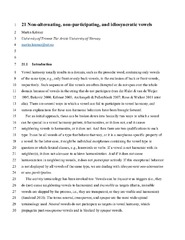| dc.contributor.author | Krämer, Martin | |
| dc.date.accessioned | 2025-03-13T13:58:34Z | |
| dc.date.available | 2025-03-13T13:58:34Z | |
| dc.date.issued | 2024 | |
| dc.description.abstract | Vowel harmony usually results in a domain, such as the prosodic word, containing only vowels 8 of the same type, e.g., only front or only back vowels, to the exclusion of back or front vowels, 9 respectively. Such sequences of like vowels are often disrupted or do not span over the whole 10 domain because of vowels in the string that do not participate (van der Hulst & van de Weijer 11 1995; Baković 2000; Krämer 2003; Archangeli & Pulleyblank 2007; Rose & Walker 2011 inter 12 alia). There are several ways in which a vowel can fail to participate in vowel harmony, and 13 various explanations for these non-harmonic behaviors have been brought forward. | en_US |
| dc.identifier.citation | Krämer M: Non-alternating, non-participating, and idiosyncratic vowels. In: Hulst Hvd, Ritter N. The Oxford Handbook of Vowel Harmony, 2024. Oxford University Press p. 244-268 | en_US |
| dc.identifier.cristinID | FRIDAID 2316137 | |
| dc.identifier.isbn | 9780198826804 | |
| dc.identifier.uri | https://hdl.handle.net/10037/36684 | |
| dc.language.iso | eng | en_US |
| dc.publisher | Oxford University Press | en_US |
| dc.relation.uri | https://blogg.uit.no/mkr001/wp-content/uploads/sites/98/2025/02/21-Nonalternating-vowels-ultimate-final.pdf | |
| dc.rights.accessRights | openAccess | en_US |
| dc.rights.holder | Copyright 2024 The Author(s) | en_US |
| dc.title | Non-alternating, non-participating, and idiosyncratic vowels | en_US |
| dc.type.version | acceptedVersion | en_US |
| dc.type | Chapter | en_US |
| dc.type | Bokkapittel | en_US |


 English
English norsk
norsk